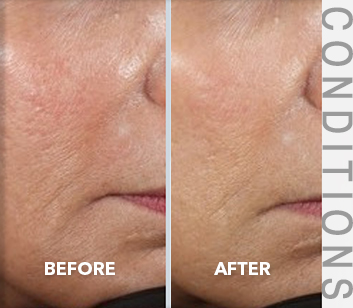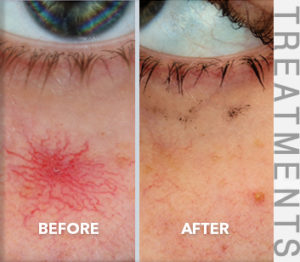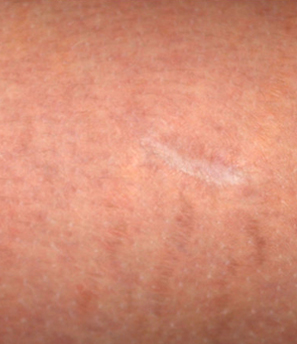Conditions
Red Stretch Marks (STRIAE)
Results of Treatment
Vascular lasers will easily remove the redness from stretch marks while gradually improving their texture over time.
About Red Stretch Marks (STRIAE)
Stretch marks result from inflammation that damages the elastic fibers in linear patches of skin causing thinning of the skin, or atrophy, and redness indicative of inflammation. Stretch marks are best treated while they are red to get maximal improvement. Lasers are quite good at removing the redness and IMPROVING the texture of stretch marks, but they cannot be removed. Vascular lasers, such as the V-Beam Perfecta®, V-Beam Prima® and Excel-V®, are great at targeting and removing redness, while also stimulating a hive reaction that remodels the damaged elastic tissue. Once stretch marks lose their red color, laser treatments offer much less improvement. During this phase, the non-ablative fractionated lasers, such as the Fraxel® Dual, are often used, resulting in much less improvement than is seen when treating red stretch marks.
Stretch marks result from damage to elastic fibers in the skin, often due to hormonal changes such as pregnancy, large changes in one’s weight, hormonal birth control use, and oral or topical corticosteroid medications. Most people attribute stretch marks to physical factors such as stretching of skin from weight gain, increased muscle mass from weight lifting stretching out the skin, or physical activity that causes the elastic fibers in the skin to stretch and break; however, it is more often the hormonal changes that accompany weight gain, internal hormonal imbalances or administered corticosteroids that lead to stretch marks. Restoring elastic fibers to skin once they are damaged or lost is a very difficult thing to do. Agents that repair sun-damaged skin offer some help to improving the appearance of stretch marks, since sun also damages elastic fibers, but in a different way. Retin-A® (and other retinoids) and AHAs (such as ammonium lactate or glycolic acid) improve stretch marks very gradually over time by remodeling the connective tissue beneath the surface of the skin.
If stretch marks are red, vascular lasers are extremely effective at improving them, often in combination with AHAs or retinoids. Vascular lasers will easily remove the redness from stretch marks while gradually improving their texture over time. Still, improvement of skin-colored stretch marks is very challenging, with lasers offering only modest improvement. Topical AHAs can help improve the texture of skin-colored stretch marks to a small degree with continued use.
To answer your specific questions or schedule a consultation, call Dr. Bernstein today at 610-645-5551.
Did you know?
Dr. Bernstein was the first physician in the WORLD to use the V-Beam Perfecta® and V-Beam Prima® lasers and one of the first in the U.S. to acquire the Excel-V® laser has published numerous peer-reviewed articles on treating numerous conditions with these lasers and has published extensively on their use.
Red Stretch Marks FAQs
ARE STRETCH MARKS FROM STRETCHING MY SKIN?
Although stretch marks often occur in areas where skin stretches such as the abdomen, shoulders and sides; it is hormonal changes that are the biggest cause of stretch marks. This is evidenced by the fact that strong steroid creams can create stretch marks anywhere on the body. It’s likely the combination of hormonal changes and stretching or hormonal changes alone that lead to stretch marks.
IS THERE ANYTHING I CAN PUT ON MY SKIN TO PREVENT STRETCH MARKS?
Because stretch marks result from hormonal changes that take place during pregnancy, dramatic weight changes, corticosteroid medications or other conditions that alter hormonal status there isn’t much one can do to prevent them.
WHY DO STRETCH MARKS GET RED?
Stretch marks result from inflammation brought about by hormonal changes in the skin. The inflamed areas look red and often itch while stretch marks are actively forming.
WHAT TYPE OF STRETCH MARKS RESPOND BEST TO TREATMENT?
Red stretch marks are in the process of forming and are therefore most amenable to treatment. Vascular lasers such as the V-Beam Perfecta®, V-Beam Prima® and Excel-V® target the redness within stretch marks, reduce the inflammation and remodel the deeper layer of skin including damaged elastic fibers. Skin-colored stretch marks are not improved much by vascular lasers as there is little, if any, redness for those lasers to target. They are often treated with non-ablative fractionated lasers such as the Fraxel® Dual which makes tiny microthermal injuries thus stimulating remodeling. Skin-colored stretch marks improve modestly from this treatment.
HOW MANY LASER TREATMENTS WILL I NEED?
Everyone’s stretch marks are unique and people respond differently to laser treatment. On average, it takes 2-3 treatments to improve red stretch marks significantly. Generally this will remove the redness making further treatment with vascular lasers ineffective.
HOW FAR APART ARE LASER TREATMENTS?
We administer laser treatments for stretch marks at 2-3 month intervals.
WHAT ARE THE POSSIBLE SIDE EFFECTS OF LASER TREATMENT?
Laser treatment of stretch marks turns the stretch marks red and possibly purple from bruising. Redness resolves in a few days, while bruising can take 2 weeks to resolve.
DOES LASER TREATMENT OF STRETCH MARKS HURT?
We don’t use numbing cream before treating stretch marks, but treatment stings a little because many of the areas where they occur, such as the abdomen, thighs and sides can be sensitive. People find treatment annoying yet quite bearable.
HOW DO I CARE FOR THE TREATED AREA?
There is little, if any, aftercare necessary for treated areas. You can apply petrolatum (Vaseline® or Aquaphor®) to the treated areas a few times a day, for couple of days if the treated area is irritated or itchy.
WHAT CAN I DO FOR SKIN-COLORED STRETCH MARKS?
While we don’t use lasers to treat skin-colored stretch marks, topical AHAs (like glycolic acid or ammonium lactate lotions) often help improve their texture by remodeling the skin over time with continued use.







